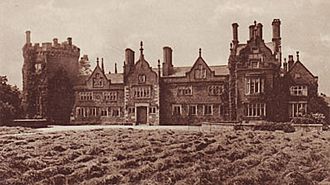Penwortham Priory facts for kids
Quick facts for kids Penwortham Priory |
|
|---|---|

Penwortham Priory
|
|
| General information | |
| Architectural style | Jacobean |
| Town or city | Penwortham |
| Country | England |
| Coordinates | 53°44′55″N 2°43′48″W / 53.7486°N 2.7299°W |
| Construction started | 1535 |
| Completed | 1850s |
| Demolished | 1920s |
| Client | Rawathorne Family |
| Technical details | |
| Structural system | Brick |
| Design and construction | |
| Architect | George Webster |
Penwortham Priory was once a special religious building called a Benedictine priory. A priory is a type of monastery where monks or nuns live and pray. Later, after a big change in England called the Dissolution of the Monasteries, it became a large, fancy home known as a country house.
This historic place was located in the village of Penwortham, close to Preston, in Lancashire, England. Sadly, the house was taken down in the 1920s as Penwortham grew into a town. Today, a housing estate stands where the priory and its grounds once were, and no parts of the original building remain.
The Priory's Beginnings
The story of Penwortham Priory starts a very long time ago, even before the year 1086. At that time, William the Conqueror, who was the King of England, gave this area of Lancashire to his relative, a man named Roger the Poitevin.
Roger decided to build a small castle on a hill in Penwortham. This castle overlooked the river, which was an important crossing point. You can still see the castle mound, which is called a motte, behind St Mary's Church today.
Roger also gave some land to a group of Benedictine monks from Evesham Abbey. In 1075, they began building a smaller religious house in Penwortham. This new priory was like a branch of Evesham Abbey and was dedicated to Saint Mary. It operated as a priory until 1535.
Becoming a Grand House
In 1535, a major event happened in England called the Dissolution of the Monasteries. This was when King Henry VIII closed down many monasteries and priories across the country. Penwortham Priory was one of them.
After it was closed, the priory and its lands were sold to the Fleetwood family for £3,088. The Fleetwood family then built a large, grand house on the site. They named this new home Penwortham Priory, keeping the historical name alive. The Fleetwood family lived in this mansion until 1749.
Later, in 1783, the Rawsthorne family took ownership of the Priory. In the mid-1800s, they hired a famous architect named George Webster to redesign and update the house.
Why Was the Priory Demolished?
Over time, the village of Penwortham began to grow much larger, especially after the First World War. This expansion meant that the land where Penwortham Priory stood became very valuable for new homes.
In 1912, a smaller building on the estate, called the Lodge, was carefully taken down and rebuilt in a different location in Hutton. Finally, the main Penwortham Priory house itself was demolished in 1925. This made way for the new housing developments that you see in the area today.

